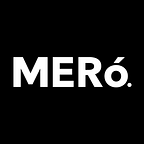Thinking of a rebrand? What Mastercard’s new logo tells us about future design trends
Last week Mastercard unveiled their new branding, revealing a simple, pared back logo with clean typography and warm, bold colours. Here at MERó we are in favour of the new design. As great believers in “less is more”, we like the simplicity of the stripped back mark.
The redesign is the work of Pentagram, who have helped to refresh and refine the company’s look whilst retaining their iconic visual identity. Rebranding a company this size is a quite a feat considering it is one of the most recognised and populous brands across the globe. Found in nearly every country on the planet, over 2.3 billion of us (thats 2,300,000,000) have their logo in our back pocket.
The world has changed significantly in the 20 years since Mastercard’s last rebrand back in 1996, the largest shift being the advent of digital. Pentagram describe the project as the “evolution of the brand identity to emphasise simplicity, connectivity and seamlessness” — the reincarnation of Mastercard into the digital world.
This “simplicity and seamlessness” is something that is seen in the pared back, minimalistic marker. The typography has been straightened and stripped. Gone are the italics and drop shadow. The iconic circles remain, but the interlocking teeth have been removed and the yellow and red disks are layered over one another in a venn diagram. The overall result is a clean, bold logo which is direct and straightforward.
The new look fares much better in the digital landscape than its predecessors. Cindy Chastain, head of customer experience & design describes their newly launched identity; “It’s simplified. It’s modernised and optimised for relevance in an increasingly digital world.”
This is a brief we regularly come across with our clients — businesses who occupy the digital and tangible worlds and are keen to keep a consistent identity across both. Designing with digital presence in mind helps clients to navigate this challenge.
In recent years some of the world’s most prolific companies have also rebranded with a shift towards digital-first design. Starbucks, Google and PayPal have all had a facelift, creating stripped back markers, selecting bold, creamy colour palettes and using simplified typography. The result is a trend for uncomplicated design that is easy to read across any device.
Not only is this style practical and visually appealing, but we think it will be around for a while.
Rebranding an organisation like Mastercard is expensive, time consuming and risky. Because of this, large organisations invest in extensive research and testing. With the associated expense, they have to ensure that a new design retains its value by remaining up to date for several years: they simply can’t afford a facelift every 18 months. This means that large companies typically favour design styles and tropes that are forward-thinking and ahead of the curve, ensuring their investment has longevity.
If you are looking to rebrand your business, it is worth taking a look at the choices made by these companies. We can benefit from their investment and learn about trends and styles that will be with us for some time. Here at MERó we recommend “digital first” to our clients as it affords you this longevity. If you choose to follow suit with your company’s rebrand, you might just find the investment pays off.
